Integrated, organic production systems evaluated for 'liberty' apple

Commercial apple growers in the northeastern United States are faced with challenges ranging from disease and insect invasions to tree nutrition and crop load. These and other problems create barriers to effective adoption of integrated fruit production (IFP) and organic fruit production (OFP) of apples, limiting growers' access to potentially lucrative alternative markets. In a recent issue of HortScience, Cornell University scientists report on a systems-based approach to evaluate IFP and OFP in disease-resistant 'Liberty' apples. The study results suggested that IFP could be widely implemented in the northeastern United States, but that lack of market incentives might impede adoption of the system. The use of an OFP system also showed potential for success, but the researchers noted that price premiums would be necessary to offset the reduced profitability incurred from pests, poor fruit finish, and small fruit size.
The 4-year study, conducted in an established, high-density commercial orchard, showed that the IFP grown apples had between 3-6% insect damage (within normal percentages for this region) and between 3-17% total damage (either internal or cosmetic). The OFP grown apples had between 3-25% insect damage and 3-75% total damage, varying greatly from year to year.
According to Cornell's Gregory M. Peck, the research showed it was possible to produce marketable yields of apples in New York's humid growing conditions under both IFP and OFP systems. "These systems both used a holistic approach that included soil quality improvement, cultural practices for arthropod control, and an intensive IPM program." Peck pointed out that the study evaluated a scab-resistant cultivar (Malus x domestica Borkh.), adding; "Although there are several effective and economical fungicides approved for IFP, an apple orchard of disease-susceptible cultivars for OFP would have to rely on repeated applications of sulfur, lime sulfur, and copper for disease control. The use of these materials would undermine the sustainability of OFP for apple growers in the northeastern United States."
Organic fruit production systems are reported to be more expensive than conventional and integrated systems, and this was borne out the experiment. Sales value was estimated to be 6% greater for OFP than IFP using direct market prices (e.g., farm stand or farmers' market) and 11% greater for IFP than OFP using wholesale market prices.
The researchers concluded that IFP could be widely implemented for apple production in New York State, but cautioned that due to higher production costs, OFP may be most feasible for small to midsized direct market operations.
More information: The complete study and abstract are available on the ASHS HortScience electronic journal web site: hortsci.ashspublications.org/c … t/abstract/45/7/1038
Provided by American Society for Horticultural Science
















